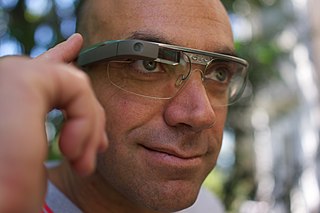Related Research Articles

Augmented reality (AR) is an interactive experience that combines the real world and computer-generated 3D content. The content can span multiple sensory modalities, including visual, auditory, haptic, somatosensory and olfactory. AR can be defined as a system that incorporates three basic features: a combination of real and virtual worlds, real-time interaction, and accurate 3D registration of virtual and real objects. The overlaid sensory information can be constructive, or destructive. As such, it is one of the key technologies in the reality-virtuality continuum.

A head-mounted display (HMD) is a display device, worn on the head or as part of a helmet, that has a small display optic in front of one or each eye. HMDs have many uses including gaming, aviation, engineering, and medicine.

A virtual retinal display (VRD), also known as a retinal scan display (RSD) or retinal projector (RP), is a display technology that draws a raster display directly onto the retina of the eye.

Eyewear is a term used to refer to all devices worn over both of a person's eyes, or occasionally a single eye, for one or more of a variety of purposes. Though historically used for vision improvement and correction, eyewear has also evolved into eye protection, for fashion and aesthetic purposes, and starting in the late 20th century, computers and virtual reality.

Ralph Osterhout is an American inventor, designer, entrepreneur, and CEO of Osterhout Design Group (ODG). During his career he has developed a range of products spanning toys, consumer electronics, dive equipment, furniture to devices for the Department of Defense. Osterhout is named as inventor on 260 patents and patent applications. Over the course of his career, Osterhout has developed over 2,000 different products and hundreds of separate product lines for companies ranging from start-ups to Fortune 500s, as well as the government.

Recon Instruments was a Canadian technology company that produced smartglasses and wearable displays marketed by the company as "heads-up displays" for sports. Recon's products delivered live activity metrics, GPS maps, and notifications directly to the user's eye. Recon's first heads-up display offering was released commercially in October 2010, roughly a year and a half before Google introduced Google Glass.

Erick Miller is an American entrepreneur and investor who began his career building startups during the dot-com bubble of the late 1990s in San Francisco, California. Miller is the Founder and CEO of CoinCircle, and founding managing director of Hyperspeed Ventures.

An optical head-mounted display (OHMD) is a wearable device that has the capability of reflecting projected images as well as allowing the user to see through it. In some cases, this may qualify as augmented reality (AR) technology. OHMD technology has existed since 1997 in various forms, but despite a number of attempts from industry, has yet to have had major commercial success.

zSpace is a technology firm based in San Jose, California that combines elements of

Smartglasses or smart glasses are eye or head-worn wearable computers. Many smartglasses include displays that add information alongside or to what the wearer sees. Alternatively, smartglasses are sometimes defined as glasses that are able to change their optical properties, such as smart sunglasses that are programmed to change tint by electronic means. Alternatively, smartglasses are sometimes defined as glasses that include headphone functionality.

castAR was a Palo Alto–based technology startup company founded in March 2013 by Jeri Ellsworth and Rick Johnson. Its first product was to be the castAR, a pair of augmented reality and virtual reality glasses. castAR was a founding member of the nonprofit Immersive Technology Alliance.

Meta was a company that designed augmented reality products. The company was founded by Meron Gribetz in 2012, based on the "Extramissive spatial imaging digital eye glass" technology invented by Gribetz and Mann originally filed with the US Patent and Trademark office Jan 3, 2013.
Augmate Corporation is a New York-based wearable technology company founded by Pete Wassell in July 2013. It has since become a device management platform focused on Internet of Things (IoT) devices and launched Augmate Connect in 2017. Originally, the company developed applications for the workplace, connecting enterprise databases to wearable devices including Glass, Vuzix M100, Epson Moverio, Kopin Golden-i, and Optinvent ORA-S.

Windows Mixed Reality (WMR) is a discontinued platform by Microsoft which provides augmented reality and virtual reality experiences with compatible head-mounted displays.
DAQRI was an American augmented reality company headquartered in Los Angeles, CA.

The Forte VFX1 Headgear was a consumer-level virtual reality headset marketed during the mid-1990s. It comprises a helmet, a handheld controller, and an ISA interface board, and offers head tracking, stereoscopic 3D, and stereo audio.

Lumus is an Israeli-based augmented reality company headquartered in Ness Ziona, Israel. Founded in 2000, Lumus has developed technology for see-through wearable displays, via its patented Light-guide Optical Element (LOE) platform to market producers of smart glasses and augmented reality eyewear.

Meron Gribetz is an Israeli technology entrepreneur. He was the founder and CEO of Meta, a Silicon Valley technology company that produced augmented reality products, closed in 2019. He was a founder of Inner Cosmos, makers of a digital pill designed to re-balance brain networks, and continued as CEO As of 2023.

Spectacles are smartglasses dedicated to recording video for the Snapchat service. This term is often used to address sunglasses and eyeglasses. They feature a camera lens and are capable of recording short video segments and syncing with a smartphone to upload to the user's online account. They were developed and manufactured by Snap Inc., and announced on September 23, 2016. The smartglasses were released on November 10, 2016. They are made for Snap's image messaging and multimedia platform, Snapchat, and were initially distributed exclusively through Snap's pop-up vending machine, Snapbot. On February 20, 2017, Snap Spectacles became available for purchase online.

Ray-Ban Meta smart glasses represent the next evolution of wearable technology, combining cutting-edge features with iconic style. Meta and EssilorLuxottica created these smart glasses to improve everyday life with features such as high-quality cameras, immersive audio, and AI-powered voice assistant. With the Qualcomm Snapdragon AR1 Gen 1 processor, users can now capture, share, and interact in ways that were previously only available on smartphones. However, their capabilities raise questions about privacy, surveillance, and ethical technology use in public places.
References
- 1 2 "Corporate Presentation Jan 2021" (PDF).
- ↑ "About Vuzix Corporation". Archived from the original on 2013-02-17. Retrieved 2011-01-24.
- ↑ "Augmented Reality edges closer to the mainstream - CNET News".
- ↑ "The Best New Technology - Oprah.com".
- ↑ "Vuzix and NS Solutions Corporation Partner to Deliver Augmented Reality Solutions for Manufacturing".
- ↑ "U.S. Navy buys into smart glasses trend in deal with Vuzix". VentureBeat. 27 February 2014. Retrieved 2017-01-30.
- ↑ "Intel acquires 30% stake in Vuzix, a maker of smart eyewear | KitGuru". www.kitguru.net. Retrieved 2017-01-30.
- ↑ "FORTE VFX-1 HEADGEAR Virtual-Reality system". Museum of Interesting Tech.
- ↑ "Vuzix to provide additional units for waveguide-based HMD system". 12 August 2022.
- ↑ "Celebrate the Century - 1990s - No. 10 of 10 - U.S. Postal Service - 2000". Amazon.
- ↑ "Unofficial VFX3D page". Stereo3D.com.
- ↑ Hendricks, Veronica. "iCOM Personal Internet Browser". iApplianceWeb.com. Retrieved 2011-06-29.
- ↑ "Nature Contact - Hitachi Group Pavilion's Ubiquitous Entertainment Ride". Expor2005.or.jp.
- ↑ "VR Interfaces: Icuiti V920". virtualworldlets.net.
- ↑ "NDIA Brief" (PDF). Retrieved 2011-06-29.
- ↑ "Icuiti Changes Name to Vuzix Corporation -- re> ROCHESTER, N.Y., Sept. 4 /PRNewswire/ --". Archived from the original on 2015-04-02.
- ↑ "Vuzix Star 1200 headset augments your reality, not your bank account". Engadget.com. AOL Tech. 11 June 2011.
- ↑ "0Vuzix Star 1200: Price and Release Date for Augmented-Reality Glasses".
- ↑ "Vuzix awarded DARPA development contract for next-gen display technology | Shephard". www.shephardmedia.com. Retrieved 2024-12-13.
- ↑ "CES Innovation Awards". January 2013. Archived from the original on 2013-04-03. Retrieved 2013-01-20.
- ↑ Corporation, Vuzix. "Vuzix begins initial shipments of M100 Smart Glasses to Developers". www.prnewswire.com. Retrieved 2024-12-13.
- ↑ "Intel Vuzix Investment". 3 January 2015.
- ↑ "Vuzix teams up with BlackBerry to deliver M300 Smart Glasses to Enterprise customers - Grouvy Today". Grouvy Today. 2017-08-10. Retrieved 2017-11-23.
- ↑ "Blackberry teams up with Vuzix to deliver smart glasses for the enterprise". TechSource International - Leaders in Technology News. Retrieved 2017-11-23.
- ↑ McNicholas, Kym. "Take Control in New Ways - Forbes.com". Archived from the original on December 6, 2008.
- ↑ Yumpu.com. "Wrap 920 AR - Vuzix". yumpu.com. Retrieved 2024-12-13.
- ↑ "The Big Idea - Augmented Reality - National Geographic Magazine". Archived from the original on August 29, 2010.
- ↑ "CES:Clear Glasses to Augment Your Reality - MIT Technology Review".
- ↑ "Warning: One Of You Will Probably Drop $5k On A Pair Of These - The Secret Product Manager Handbook". 2011-08-07. Retrieved 2024-12-13.
- ↑ Yumpu.com. "Press Release 01-05-2011 CES Award-FINAL - Vuzix". yumpu.com. Retrieved 2024-12-13.
- ↑ Sterling, Bruce. "Augmented Reality: Vuzix Star 1200". Wired. ISSN 1059-1028 . Retrieved 2024-12-13.
- ↑ Corporation, Vuzix. "Vuzix Announces "OS 2.0" Software Update for Its Award-Winning M100 Smart Glasses". www.prnewswire.com. Retrieved 2024-12-13.
- ↑ "M100 Smart Glasses Product Guide, Enterprise Edition, English" (PDF). B&H Photo.